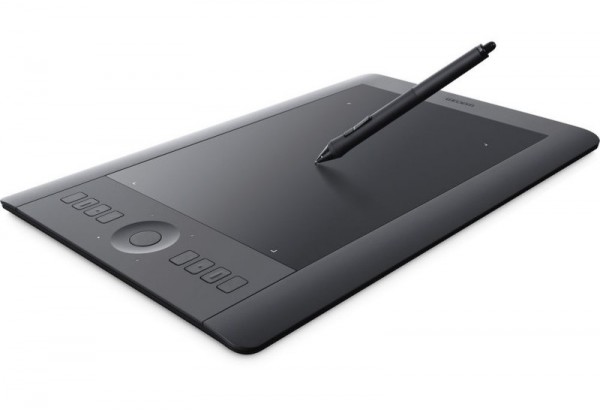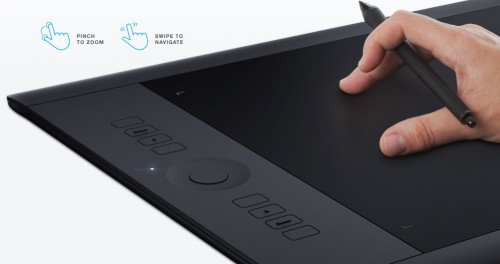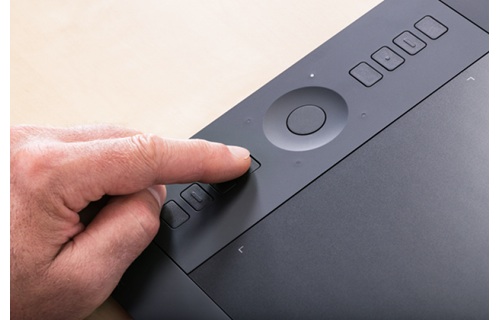Current Instant Rebate: Save $50 on the Wacom Intuos Pro.
Call me a convert. I’m officially a graphics tablet guy now.
I don’t know about you, but after computing for something like 26 or 27 years, I’m kind of over the mouse. Sure, it was a great invention at the time, and for that we have Steve Jobs to thank, but seriously. It’s kind of depressing to think about exactly how much of our lives are spent cradling that little plastic puck.
Yes, we’re finally seeing touch screen computers starting to take over the world, which means we’ve officially entered the future. Those work great for things like checkout counters, but for the kind of work that you and I do, those just aren’t very practical. Can you imagine sitting at your desk and spending hours each day with your arm outstretched up at the monitor? That would suck after about an hour. Maybe ten minutes.
Then there’s the trackpad and the swipe gestures on the mouse. I don’t have an Apple trackpad, but I do use swipe gestures on my mouse, but again- still tied to the mouse.
I’ve known about Wacom graphics tablets for a long time, but never really thought about getting one until recently. I’m not sure what clicked in my mind, but I tried one out again at PhotoPlus back in October and was hooked. I ordered an Intuos Pro Medium Tablet on the spot and have been incredibly pleased with it ever since it arrived.
In this review, I’ll run down the main features and then let you know how I’ve been using it in my workflow. (You can check out more info about the Intuos Pro Tablet at the Wacom Website.)
Design
As you can see in the picture above, the Wacom Intuos Pro is pretty straightforward. Essentially, it’s a big trackpad with eight buttons and a scroll wheel on the left side. It comes in three sizes, but the medium version is 14.5″ x 9.5″, which is about the same size as a 13″ Mac Book Pro. Maybe a tiny bit bigger, but it will fit in most laptop bags and packs that hold that size laptop, and it’s flat enough that it should fit along WITH your laptop.
The pad works either with the included pen, or it can function as a multi-gesture trackpad that you can use with your fingers. And it works with any monitor setup, even if you have dual screens.
The left side buttons and wheel are all programmable, and you can make them all application specific. This means you can assign them differently to any program that you use. Finally, it has a battery and USB plug that allows you to use the unit wirelessly, so either on the road, or in your lap at your desk. Pretty cool.
Functionality
As I mentioned, the Wacom Intuos Pro can either be used with the pen or it can function as a trackpad. Both ways work great, and I’m quite impressed with how easy it is to use with your fingers. As much as I like using the pen, I find myself using it this way pretty often.
In the control panel, you can set up for your multi-touch gestures, whether for one, two, three, four, or even five fingers. Swipes, touches, taps, pinches all work great with the computer’s OS, and most of the gestures are customizable for different applications.
The pen is more precise, although it takes a little while to get used to it. The pen is mapped specifically to the screen, so wherever you are on the tablet with the pen corresponds to where you are on your monitor(s).
This is different from how a mouse and trackpad works. With the mouse, the cursor is wherever you left it on the screen, and so if you lift up the mouse (or your finger), you start again where you left off. Since we’ve all been mousing for years, this is completely intuitive.
However, as I said, the pen is always mapped, so while it seems a little strange at first, once you get used to it, you’ll actually find it to be a very precise input device.
Add to that the fact that the pen is capable of detecting 2048 levels of pressure, which makes it an extremely versatile device for doing critical Photoshop, drawing and design work, since pen pressure translates to things like brush size and line strength. This is obviously the real strength of graphics tablets.
Finally, the pen also has two programmable buttons, and an “eraser.”
In Use
Pen and Trackpad
I have mine positioned right in front of the keyboard, although some people place it off to the side where the mouse pad would usually be. I’m still new at this and I may refine my placement in the coming months, but for now, I like this setup.
As I said, I use the trackpad and gestures quite often. If I’m just sitting down and doing quick tasks, I’ll use my fingers. Like right now. I’m going between typing this post, looking at Twitter and checking my email, all using the tablet like a trackpad.
With gestures like one finger click, two finger scroll, and three finger select and drag, I can get anywhere on the screen and do any task without grabbing the mouse. In fact, since I got the tablet, I rarely use the mouse anymore.
That said, I do use the pen a lot, and I really like how it functions. It feels very precise. Very deliberate. Very tactile. It’s great for dragging sliders and dust spotting. With one button, you can also put the tablet in and out of “Precision Mode,” which lets you be incredibly accurate with the pen. This is great for critical editing and retouching work.
Sometimes I combine pen use with finger taps and scrolls. I find that the pen works really well for Photoshop work, and also for applications like Logic Pro (music and recording) and even my occasional binge with video games.
Buttons and Scroll Wheel
Although mousing, tracking and penning can get you by for simple tasks like reading emails, opening folders, dragging files and surfing the web, for any serious computing work, you use other keys and keystrokes.
This is where the buttons and scroll wheel come in extremely handy. In fact, they’re the vital feature on the Intuos Pro tablets. As I pointed out, you can assign them to be application specific. This is totally key, because you can completely customize your entire workflow and computing around having these eight buttons and the wheel do different things inside different programs.
For example, when I’m using Lightroom, my top four buttons are set to G, D, C, N, which correspond to Grid mode (Library Panel), Develop mode, Survey and Compare. The bottom four buttons are set to Pick, Flag, Shift and Command.
I can swipe between images with my fingers, scroll through the library with the scroll wheel, select with my finger or the pen, page up and down with the pen buttons, and use the buttons to pick, flag, select multiple images, etc….
For other programs, I have the buttons set to things like Copy, Paste, Undo, Right and Left Arrow, Zoom image, and the list goes on. Totally customizable. You can set it up to match your own workflow and make it so you can do just about everything with the tablet.
What about typing? You can even have it set to bring up an on-screen keyboard that you can control with the pen or your finger. I wouldn’t write a long email or blog post with the on-screen keyboard, but for simple tagging, and adding a couple of keywords, why not?
Additional On-Screen Menus
As if the buttons weren’t enough, you have even more options with the Radial Menu, App Shortcuts Panel, Brush Tools, and the Photoshop Specific menus.
The Radial Menu is especially cool, because when you bring it up, (I have mine set up to show with three finger tap) you have access to 8 more options. I have some of them set to paste specific bits of text/code that I often use, which save me a lot of time, and another to bring up the on-screen keyboard.
The App Shortcuts let you tap to page up and down, copy, paste, undo, find and more. You get the idea. Lots of options. That’s what I like about this setup, I have multiple ways of doing everything, without having to rely on the mouse and keyboard for EVERYTHING.
Ergonomics
I can’t tell you how nice it is not to be tied to the mouse anymore. I also like that I can unplug the tablet, go wireless, then sit back and edit photos with the tablet in my lap. Yes, there are some iPad apps that let you do this, but the graphics tablet just has so many other options and much more expanded functionality.
Overall, I really like the tactile feel of the Intuos Pro. Between the precision of the pen, the ease of the touch/trackpad feature, and the control buttons on the side, I feel like I have a high degree of control over my input, and great ergonomic variation, which for the amount of computer work I do, adds up to greatly reduced repetitive stress on any one muscle group in my hands and forearm muscles.
I don’t know about you, but after few consecutive, long days of editing or writing, my arm hurts when I’m using the mouse. With this setup, I can change things up and alleviate this problem. In the grand scheme of things, that’s a very important issue.
So, is there a downside to using a tablet like this? Well, for one, you suddenly lose a big open, laptop-sized spot on your desk. I can see that being an issue with some people. I’ve got a pretty big desk, though, so it’s not a big deal with me. Besides, when there was no tablet, I’d just pile stuff there anyway. In a way this tidies things up for me.
Also, it takes a little while to get used the pen. We’re all so used to using the mouse that the pen might seem a little twitchy at first. You get used to it, and you find yourself a bit more calm and deliberate, (at least I do,) when using the pen. That said, a tablet setup is probably not for everyone.
On the flip side, if you do lots of retouching and editing work, the pen is a pretty invaluable tool. It’s the kind of thing where once you use it, you never want to go back to the mouse. And you’d be surprised at how many people use these things. When I got my Wacom tablet, I started hearing from a number of other photographer colleagues who have them as well.
If you spend a lot of time in Photoshop, if you do any kind of sketching, drawing or painting on the computer, or if you’re just tired of the mouse, I’d highly recommend the Intuos Pro tablet. Is it a necessity? No, but it sure makes computer life more precise, more professional and more ergonomically friendly. As I said, for the amount of times we photographers spend in front of our screens, those are compelling reasons.
With the current instant rebates, you can save $50 on the Wacom Intuos Pro.
[iframe]<iframe width=”120″ scrolling=”no” height=”240″ frameborder=”0″ style=”border:none;” border=”0″ src=”http://mer54715.datafeedfile.com/widget/aff_widget_prdt_generate-2.0.php?aff_num=6746&aff_net=1&widget_num=6964&sid=” marginheight=”0″ marginwidth=”0″></iframe><iframe style=”width:120px;height:240px;” marginwidth=”0″ marginheight=”0″ scrolling=”no” frameborder=”0″ src=”//ws-na.amazon-adsystem.com/widgets/q?ServiceVersion=20070822&OneJS=1&Operation=GetAdHtml&MarketPlace=US&source=ss&ref=ss_til&ad_type=product_link&tracking_id=danhbaisadvph-20&marketplace=amazon®ion=US&placement=B00EN27SHY&asins=B00EN27SHY&linkId=TQHPFRXANGJQVOAI&show_border=true&link_opens_in_new_window=true”>
</iframe>[/iframe]



